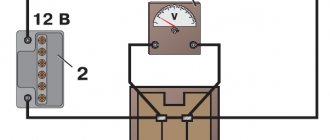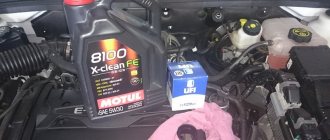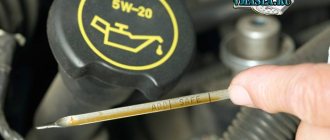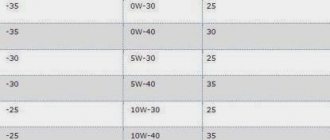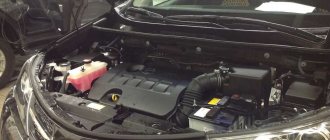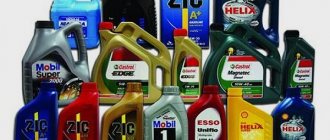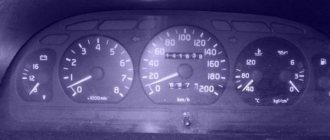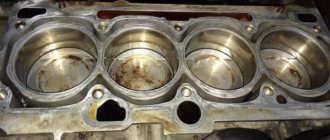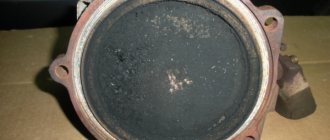Motorists' opinions on this issue
According to reviews from motorists regarding engine oil consumption, there are the following opinions on this issue:
- The engine should not lift and its level should remain in one place.
- The engine must consume a certain volume, which leads to the need to add lubricant to the required level. Motorists call this type of engine oil consumption waste.
What engine oil consumption is considered normal?
First of all, it must be said that all engines, by their design, consume lubricant in varying amounts. This process directly depends on the design of the engine itself and its main components. In other words, loss occurs during the process of supplying lubricant to the surface of the cylinders. This section of the engine is the most heat-exposed and it is here that evaporation and combustion of a certain volume occurs.
Consumption depends on engine type:
- Gasoline engines that have been produced over the past 10-15 years. should consume 0.005-0.025% per 100 liters of fuel. Based on this, per 100 km. from 5 to 25 ml should be spent.
- Gasoline engines with severe wear consume 0.4-0.6% per 100 liters of fuel. At 100 km. way, the engine consumes 0.4-0.6 liters. In some cases, consumption can reach up to 0.8% (0.8 liters per 100 liters).
- Turbine engines consume more than gasoline engines. So new power units should consume 0.08 liters. per 100 l. fuel. So for 1000 km. the engine consumes 0.08 liters. oil, and at 10,000 km. respectively 0.8 l. Worn out turbo engines can consume up to 2 liters. per 1000 km.
Diesel engines consume engine oil almost at the level of turbo engines. Normal consumption for a diesel engine is 0.3-0.5 liters. per 1000 km. Many motorists claim that consumption depends on the technical condition of the engine and its operating conditions.
Indicators of normal oil consumption for different types of engines
As described earlier, it is worth paying special attention to the type of engine in your car. Oil consumption for different engines directly depends on their design. Below are the normal consumption figures for each type of motor.
Gasoline power unit
For vehicles recently released from the production line, normal oil consumption is considered to be not more than 2.5 ml/100 liters of fuel. It is worth noting that when running in a new car, this figure can be significantly higher, since the new parts have not yet completely gotten used to each other.
The permissible value for used cars is 100 g per 100 liters of fuel. This oil consumption is typical for cars with low mileage and in good technical condition.
Increased oil consumption of about 0.5 liters per 100 liters of fuel is considered critical. At this level of lubricant consumption or higher, the engine may simply jam on the move, so at such indicators it is recommended to visit the nearest technical inspection point.
Diesel power unit
Normal fuel consumption for diesel engines is around 300-500 g/100 l. The critical consumption indicator for this type of motor is a consumption equal to 2000 g/100 l. In a diesel engine, there is constantly high pressure, which affects oil costs. Very often, diesel engines are used in construction equipment and trucks that constantly transport heavy loads. All this additional power consumption also increases lubricant consumption significantly.
Turbocharged power unit
It is worth saying that recently more and more new engines with turbines have been appearing. There are both gasoline power units with a turbine and modern turbodiesels on the market. The number of turbines can also reach 3 on one engine.
These power units have enormous power in a completely small size. It follows that oil consumption directly depends on engine power, so these units are subject to the greatest waste of lubricant.
Even a new turbocharged engine consumes about 80 g of oil per 1000 liters. For full operation of the turbine itself, lubrication is required, and if there are several turbines, then the fuel costs will be much more significant.
And so, an oil consumption rate of 1 liter per 1000 km or 100 liters of fuel for a conventional engine is a critical norm, and for 2 other types of engines the critical indicator will be 2 liters / 1000 km or 100 liters of fuel.
The reasons for excessive oil consumption may be a dirty oil filter; its condition must also be monitored and a new one must be installed during a routine oil change.
The main factors influencing the level of engine oil consumption
As previously mentioned, motor oil is consumed in all types of engines, as part of the lubricant burns out due to intense dry friction. But there are specific factors that affect the amount of lubricant consumed:
- Banal leakage from the engine. Due to the wear of some parts or their damage, oil may leak through grooves or holes formed by mechanical stress. Such weak points can be oil seals or various gaskets (valve covers, cylinder heads).
- It can also seep between the engine and gearbox through the oil seal.
- Grease may seep into the coolant, causing it to become cloudy and begin to foam.
- When the lubricant is consumed by waste, the exhaust gases acquire a bluish color.
- Malfunction of valve stem seals increases the engine's consumption of lubricant.
- Severe wear on the piston rings results in oil not being completely removed from the piston.
- Accumulation of coke and carbon deposits on the surface of the piston rings.
- Excessively increased pressure in the crankcase, which causes the lubricant to move into the cylinders, where it burns along with the fuel used.
- Poor performance of the turbocharger, which causes lubricant leakage in the supercharger area.
Ways to reduce engine lubricant consumption
Due to the fact that you cannot constantly add lubricant without understanding the reason for its disappearance, there are ways to reduce engine oil consumption by the power unit:
- operation of the power unit in a gentle mode without prolonged driving at high speeds;
- correct selection of a lubricant, according to the recommendations of the car manufacturer;
- in case of severe wear of the engine, it needs to be overhauled;
- in view of the impossibility of carrying out a major overhaul of the engine in the near future, it is advisable to switch to oil with a higher viscosity;
- switching from synthetic lubricant to semi-synthetic allows you to reduce oil consumption;
- repair or replacement of valve stem seals;
- replacement of seals located on valves;
- the use of certain brands of additives that can reduce oil consumption;
- replacing worn piston rings;
- decoking of piston rings;
- thorough flushing of the engine lubrication system with a special composition;
- adjustment to optimal crankcase gas pressure parameters;
- repair or replacement of the turbocharger.
Why is oil consumed?
To ensure maximum engine life, it is extremely important to ensure reliable protection of the surfaces of rubbing parts. First of all, the oil is supplied to the most loaded parts of the internal combustion engine: the cylinder-piston group, the gas distribution mechanism, etc. The list of elements that need lubrication includes piston rings.
- Engine oil forms an oil film on the cylinder walls to prevent the rings from destroying the cylinder bore. During engine operation, part of the oil in the form of this film is subject to heating and evaporation. The result is the usual burnout of the lubricant remaining on the cylinder walls, which is inevitable during operation of the unit. This is the main reason for oil waste.
- Another reason that a healthy diesel engine eats oil is the inevitable entry of lubricant into the intake. Some of the lubricant is squeezed out through the crankcase ventilation system. As engine wear increases, the breakthrough of gases from the combustion chamber into the crankcase becomes more active, and the pressure increases. For this reason, a diesel engine takes more oil.
- The so-called diesel engine oil burn directly relates to turbodiesel power units. The fact is that a large amount of lubricant is supplied to the turbocharger, which explains the increased consumption.
Read also: Blaupunkt Lacetti head unit instructions
Summarizing
When studying the question of what oil consumption in an engine is considered normal, you need to know the main reasons for the decrease in the volume of lubricant in the engine. First of all, you need to understand that some of the lubricant will still disappear even in perfectly working engines. In this case, you need to clearly know the normal oil consumption for a particular machine. If this indicator is exceeded, then you need to look for the reason for the excessive consumption. To do this, it is best to contact specialists at a service station, where, using special diagnostic programs, they can quickly find the location of the leak.
Sometimes the motorist himself can determine such a place by carefully inspecting the engine housing. This problem can be solved in different ways, but the most important thing is not to pretend that everything is fine with the engine if the oil disappears in increased doses. This problem cannot be solved by regularly adding oil.
Firstly, this is quite an expensive pleasure, and secondly, not solving one problem can provoke the emergence of other problems, which will ultimately lead to the need for a major overhaul of the engine.
Summary
The quality of the oil and the condition of the internal combustion engine directly affect the condition of the machine and its technical characteristics. In this regard, it is worth paying attention to the condition of the motor and its timely maintenance. This will reduce engine oil consumption and increase the service life of both the engine itself and its components.
Author:
Maxim Markov
Every car enthusiast knows for sure that for normal operation of the engine in his car, it is necessary to maintain the required level of lubrication. During operation, oil is naturally consumed and needs to be topped up. The question arises, what is considered normal engine oil consumption?
see also
Knocking in the engine when hot
- 6 1 6k
Smokes when cold
- 7 1 12k
Engine stalls when cold
- 9 0 8k
Valve cover and cylinder head sealant
- 91 3 127k
Oil starvation - main causes and consequences
- 19 0 28k
Engine oil consumption is determined depending on the amount that burns out in the engine. Excessive consumption of engine oil can indicate either poor quality (the lubricant then burns out excessively) or a malfunction of the engine itself (leakage occurs, most often through valve seals and oil scraper rings). Everything will depend on the specific numbers and additional symptoms that may appear when the lubricating fluid is lost.
How is engine oil consumption calculated?
To determine the norm, it is not the mileage value that is taken into account, but the fuel consumption. This indicator is more accurate than the distance traveled, because when you are stuck in traffic jams, the oil is depleted even more, and the odometer does not change its value.
Engine oil consumption is usually calculated based on the volume spent on burning 100 liters of fuel.
To find out the oil consumption rate in your car's engine, you need to use a calculation formula and a calculator, or use this online form. It involves calculating the permissible amount of oil for waste according to the type of engine, the volume of operating oil and the amount of fuel consumed, taking into account the condition of the piston group.
Calculation formulas for oil consumption
The total actual oil consumption for waste during its operating cycle (from replacement to replacement) can be calculated using the formula:
Where ∑q is the oil added during the cycle (between maintenance); Qз - filled during refueling; Qsl – drained during replacement.
But the consumption of poured oil in liters per 100 liters of fuel is determined as follows:
Where V is the capacity of the engine lubrication system; P – consumed fuel k – coefficient taking into account wear of the piston group (k – for a diesel car 1.25; petrol 1.15; turbo 1.3).
Engine oil consumption rate for waste
For passenger vehicles, the normal burn rate is 0.005 - 0.025% per 100 liters of fuel, which is approximately 5 to 25 grams of oil per 1 thousand km. In a worn engine it can reach up to 0.1% and 100 g. per 1000 km respectively. Well, if the car operates at the limit or has a turbocharged or diesel unit, then this norm will be even higher.
For long cargo trucks, the oil consumption rate is 0.3 - 0.4% of fuel consumption. The calculation formula uses the amount of fuel burned and oil added during this period. But this calculation of oil consumption, proposed by the automaker Scania, is relevant only for heavy cars with a large engine. Calculations of lubricant consumption in passenger cars, both with diesel and gasoline engines, have a slightly different form.
Engine oil consumption rate per 100 liters. fuel for passenger cars
| engine's type | Acceptable waste | |||
| In percent, % 100 l. fuel | In grams, g per 1000 km | |||
| New | Worn out | New | Worn out | |
| Petrol | 0,005 – 0,025 | 0,025 – 0,1 | 5 to 25 | 25 – 100 |
| Turbocharged | 0,05 – 0,08 | 0,5 – 1 | up to 100 | 100 – 300 |
| Diesel | 0,035 – 0,25 | 0,3 – 0,8 | 30 – 55 | up to 200 |
| Rotary | 0,5 – 1,2 | 1 – 2 | 500 – 1000 | up to 2000 |
A gasoline engine operating at the limit of its capabilities can consume from 0.4 to 0.6% at 100 hp. fuel consumed, which is approximately 400 - 600 grams of engine oil per 1000 km. The situation is exactly the same with diesel engines - engine lubricant consumption increases by 0.5%. But if these are forced turbodiesels with two turbines, then the consumption can reach up to 3% of the volume of oil poured into the engine.
Keep in mind that oil consumption rates increase significantly for cars after major repairs and in operation for more than five years .
Method for determining oil consumption
Oil level on dipstick
Determination of the actual value of specific engine oil consumption for waste is carried out over a mileage of 200-300 km. The vehicle must be technically sound during the test drive. The oil level in the crankcase should be between the “MAX” and “MIN” marks on the engine dipstick. Before the test run, it is necessary to warm up the engine, the oil temperature should be 80-85°C. Drain the oil on a level surface. It should drain from the pan within 15 minutes. For the accuracy of the result, it is advisable to determine not the volume, but rather the weight, since the amount of lubricant remaining in the filter can only be determined by weighing it.
The operation of which engine components and parts affects increased lubricant consumption?
The liquid inside the engine may leak out or evaporate. As a rule, evaporation occurs on the surface of overheated parts and mechanisms. Next, we will describe the main signs of incorrect operation of engine parts, which can affect the oil consumption:
- Main cylinder block. Often the gasket between the block and the cylinder head begins to leak. The problem can be identified visually;
- Crankshaft . Similar to the case described above, oil seals may leak due to severe wear. You can find the problem by disassembling the motor. In this case, the seals will have to be replaced with new ones;
- Oil filter. It may become clogged or simply not screwed on properly. The problem is easy to identify visually and replace this unit with a new one;
- Gas distribution valves. Oil seals may fail due to overheating. Oil will begin to seep into the timing mechanism. The problem is eliminated by replacing the rubber caps;
- Oil scraper rings. Wear of these rings located on the pistons is a very common problem. Blueish smoke from oil fumes begins to come out of the exhaust pipe. The situation can be corrected by replacing the rings;
- Cylinder failure. Often, under the influence of high temperatures, scuffing and excessive wear are formed in them. Oil is literally absorbed into these microcracks, causing excessive lubricant consumption. The problem can sometimes be solved by replacing the piston and oil rings, but it may also require boring or grinding the cylinders themselves;
- Turbine lubrication. The turbocharger constantly pumps air, which causes it to constantly heat up. It also needs lubrication during operation. The sizes of turbines can be very different, so you need to take into account the total volume of oil poured into the engine.
Conclusion
This text highlighted the most significant points regarding normal oil consumption in motor vehicles. The normal consumption that each type of engine should have was described, and the reasons why these excess expenses occur were described.
You should constantly monitor the level of lubricant in your car’s engine. Neither its shortage nor its excess should be allowed in equal measure. In any case, before you start using the vehicle, you should carefully study the instructions for its operation. It is also worth using fuels and lubricants recommended by the car manufacturer. In this case, the risks will be minimized.
It should be remembered that oil consumption in vehicles with decent mileage is always much higher, therefore, if the lubricant costs more than 500 grams per 100 liters of gasoline or a thousand kilometers, you should contact a service center and conduct a thorough check of the entire engine.
The problem of engine oil consumption worries many car enthusiasts. As you know, lubricant consumption is one of the important indicators of the overall condition of the engine. You can hear from some car owners that the engine does not take oil, that is, the level remains the same or remains within acceptable limits from replacement to replacement.
Others note increased or high oil consumption in the engine, which causes the need. Let us immediately note that the manufacturers themselves separately indicate the oil consumption rates in the engine. This means that the power unit can consume lubricant within certain limits, and such consumption is not a malfunction.
This phenomenon is usually called oil consumption due to waste. However, exceeding the norm for adding oil to the engine may well indicate problems with the internal combustion engine, engine, etc.
In this article we will look at what kind of “oil appetite” of various power units can be considered acceptable, as well as what factors and features affect lubricant consumption in internal combustion engines.
Read in this article
So, let's start with the fact that all engines consume motor oil to a greater or lesser extent. This happens taking into account the design features of the internal combustion engine, namely due to the urgent need to lubricate components and parts. In other words, the main loss of lubricant occurs as a result of the need to supply lubricant to the cylinder walls.
This area in the engine is a heat-loaded area. For this reason, partial evaporation and combustion of the lubricant occurs. Also, some of the oil is not removed from the cylinder walls, as a result of which the remaining lubricant burns along with the fuel in the combustion chamber.
As a rule, in modern engines the declared oil consumption is, on average, from 0.1 to 0.3% of the total fuel consumption that was spent to overcome any part of the journey. It turns out that if the car has traveled 100 km, and the consumption is 10 liters of fuel, then the norm will also be to consume, on average, 20 grams of oil.
It turns out that lubricant consumption can be considered acceptable if it does not exceed about 3 liters. per 10 thousand kilometers traveled. It is also important to understand that the consumption rate will greatly depend on the type of engine, its degree, etc.
For example, for many gasoline internal combustion engines, the norm is around 0.1%. On gasoline turbo engines, the consumption rate is noticeably higher. As for the standard, the declared lubricant consumption will be greater than any gasoline analogue and ranges, on average, from 0.8 to 3%. The indicated 3% is consumed by forced turbodiesels with two turbines, etc.
You can also separately mention rotary motors, which are particularly prone to lubricant consumption. Such units (taking into account their fully operational condition) consume about 1-1.2 liters of oil per 1000 km. mileage For reference, the manuals for different engines indicate that the norm for oil consumption for waste is 1 liter per 3 thousand km traveled, that is, about 3 liters per 10 thousand km.
At the same time, manufacturers also note that consumption directly depends on both the technical condition of the internal combustion engine and the operating characteristics of a particular vehicle (load on the unit, speed, etc.)
How to use the calculator
One of the main roles in this calculation is played by the volume of fuel burned and the volume of operating oil, as well as the type of engine. It is in relation to this volume and specifics of work that the specific oil consumption is calculated.
To calculate specific engine oil consumption, the following data is required:
- In the “fuel” field, enter the average fuel consumption in liters per 1`000 km. mileage (by default and based on calculation formulas this is 100 liters);
- In the “oil” field - the volume of oil that is regulated by the manufacturer as necessary when filling;
- Select the engine type and check if the machine has been in use for more than 5 years
- Click "calculate".
Such a calculation calculator can be an indispensable assistant for calculating the consumption rate of lubricants intended for operational accounting of the specific consumption of motor oil when justifying the need for them. After all, if not all, then many car enthusiasts have a rather wary attitude towards engine oil consumption. This service will show whether you are within the nominal values. If not, then you will have an objective reason to look for reasons and possible problems.
What's the outcome
That is, if the engine is in order, then it takes practically no oil, and you will not need to top it up until the next change. Its level will be within acceptable limits on the dipstick (within the min./max. marks). But there are cases when the manufacturer indicates consumption rates for a specific power unit (some engines eat oil), then topping it up is considered natural and is not a malfunction, but on average it does not exceed 1-2 glasses from replacement to replacement.
It is important to understand that the harder the engine runs, the more oil it burns. For example, the higher the number of revolutions, the more oil will remain in the cylinders of the car engine. Although we should not forget not only about the operating mode of the engine, but also its design. You should also not neglect the tolerances of motor oils and fill in fuels and lubricants of dubious quality.
FAQ
Formula for calculating oil consumption
Calculation of oil consumption can be carried out on waste, for the cycle of its operation between maintenance and consumption per 100 liters of burned fuel. The formulas for these two calculation options will be different. Engine oil waste from replacement to replacement is calculated by the formula: Qy = ∑q + (Qз-Qсл), where ∑q is the amount of oil added, Qз is the oil that was poured into the engine during replacement, Qсл is the amount of oil that was drained.
To calculate the consumption of the filled oil, which needed to be added only during the period of 100 liters of fuel burned by the car, the calculation formula is: Mз = V / (P*k), where V is the capacity of the entire engine lubrication system, P is the fuel consumed, k is the coefficient piston wear (varies depending on the engine, if diesel, then used - 1.25; gasoline - 1.15; turbo - 1.3).
Calculation of oil consumption per 100 liters of fuel
To calculate oil consumption per 100 liters. fuel, the total volume of the engine oil system (indicated in the technical documentation of the car) must be divided by the product of the spent fuel and the wear rate. So, for example, if 4.7 liters of oil need to be poured into the engine, then with 100 liters of fuel consumed by the engine, 30 grams of oil consumption is allowed. Thus, you can calculate the oil consumption of the engine and your car using the formula.
Engine oil consumption rate per 100 liters. fuel
In a passenger car engine, oil consumption can be considered normal in the amount of 0.005 - 0.0025% per 100 liters. fuel, which is equal to 5 - 25 g per 1 thousand km. The amount of oil required to top up an engine with significant mileage is considered normal even at 0.1% per hundred liters of fuel consumed. If this is a car with a carburetor power system, the permissible figure may be even higher by 0.2%. For trucks, the engine oil consumption rate is within 0.3 - 0.4% of fuel consumption.
Any internal combustion engine is designed in such a way that engine oil consumption cannot be zero in principle. Car manufacturers indicate lubricant consumption rates in the engine characteristics. If you observe the frequency of changing engine oil, it will remain within normal limits.
As the vehicle is used, drivers are surprised to notice that more and more oil needs to be added. Each time after measuring the level you have to pour several hundred grams. How can you determine that the consumption situation is quite normal, and when should you go for diagnostics?
Normal oil consumption for various types of internal combustion engines
As we have repeatedly written on Vodi.su, all characteristics and consumption standards are indicated in the descriptions for certain ideal conditions, which are almost impossible to create in real life. Even if you drive along the best autobahns in Germany, fill up with lubricants from the world's leading manufacturers and refuel with fuel that does not contain a single gram of harmful impurities and additives, engine oil consumption will still be a fraction of a percent higher than the promised figures.
This phenomenon is called waste consumption . Even in a properly functioning engine, some of the lubricant simply evaporates. As you know, oil forms a thin film on the walls of cylinders and pistons, which evaporates over time. The cylinder block is a heat-loaded area; very high temperatures arise here while the vehicle is moving.
There are two main approaches to calculating oil consumption:
- depending on the mileage - the more thousands of kilometers a car has traveled, the more lubricant it burns;
- percentage of fuel consumed.
Standard standards for various types of engines:
Gasoline engine
0.005-0.025 percent for every hundred liters of gasoline is an indicator for a new power unit. That is, the level will decrease very slowly, by 5-25 grams. It is almost impossible to determine such a decrease using a dipstick. It will be noticeable after filling 500-600 liters of gasoline and driving several thousand kilometers.
If the engine is already quite worn out, then normal consumption rates can reach 0.1 percent of the volume of gasoline poured. This is approximately 100 grams per thousand kilometers. This does not take into account that leaks can occur due to cracks in the oil-conducting tubes or wear of the seals.
Turbocharged engine
A turbine is installed to redirect the exhaust into the cylinders to completely burn the remaining fuel. Due to this, power increases, but more oil has to be consumed, since the turbine impeller can only operate normally in an oil bath.
Normal consumption for a new unit is considered to be 0.03-0.08 percent of the filled fuel. That is, after each refueling, approximately 80 milliliters of oil burns out per hundred liters. If you filled in 10 thousand liters of fuel and drove more than 10 thousand km, you will have to add about 800 ml.
For already seasoned engines, this figure can be close to 0.2% - about two liters need to be added for every 10 thousand mileage. If the consumption is even higher, then there is a problem with the turbine and it needs to be repaired.
Diesel engine
The diesel engine is also equipped with a turbine and the standards for it are the same as for a turbocharged gasoline unit - 300-800 grams for a new one and about 2 liters for a worn-out engine. If the consumption exceeds these indicators, you need to look for the reason in the technical condition.
Exceeding consumption standards
In the vehicle instructions, the manufacturer indicates the permissible standards for lubricants. You can even make an approximate table for passenger cars with an engine capacity of up to two liters:
- Volkswagen - no more than 1.5 liters with a mileage of 10 thousand km;
- BMW - from 700 ml to 1.5 l;
- Mercedes-Benz - up to one liter.
For domestic UAZ Patriot, Niva 4x4, VAZ, consumption of 0.2 percent of the filled fuel is considered normal.
A completely logical question arises: what to do if the consumption exceeds this same 0.2 percent? Should I immediately go to the service station and order a major repair?
Indeed, you should start to worry if your small car requires topping up 3 liters after a run of 10,000 km. However, overhaul is a rather expensive undertaking. It will be cheaper to check sealing elements and hoses.
As flow increases, pay attention to the following items:
- head gasket;
- crankshaft oil seals;
- valve seals (oil seals) and camshaft;
- oil pump, etc.
If the cylinder head gasket requires replacement, engine oil may get into the antifreeze. You won’t notice any manifestations on the outside, but the oil will foam, and the antifreeze will turn brown.
A sign of problems is also bluish smoke from the muffler, indicating that the oil is evaporating more intensely in the cylinders. The most obvious cause is stuck or worn piston rings. In parallel with this, there is a drop in compression and the appearance of carbon deposits on the spark plugs.
You can reduce consumption by switching to a more viscous oil or from synthetic to semi-synthetic. For worn out engines they buy mineral water. Do not forget also about seasonal replacement of lubricants. Well, a major overhaul is a last resort. Foreign cars require it with a mileage of 250 thousand km, Chinese and domestic cars - 150-200 thousand km.
Certain parameters help assess the condition of a car engine, for example, oil consumption. For power units of different types, normal level indicators differ; in addition, oil consumption is determined by wear of parts. When parameters are exceeded, this is a reason to conduct diagnostics or check how high-quality lubricants are used.
Atmospheric gasoline engine
The appearance of a leak through the crankshaft oil seals can be easily diagnosed by visually inspecting the engine compartment.
The presence of fresh oil leaks is clearly visible. It is more difficult to diagnose leaks if you constantly wash the engine with Karcher and various available chemicals. It wouldn't hurt to look under the car. If an oil puddle is visible after inactivity, then this is a clear sign of a leak through the seals. Typically, oil begins to leak as a result of wear on the sealing edges of the crankshaft oil seals and the natural aging of the rubber part. Leaks are also possible if you use motor oil that does not meet the viscosity parameters for use in a particular engine. Oil seals can leak if too liquid 5 W-40 synthetic is poured into an old diesel engine, for example, designed for 15-W40 mineral water.
Additionally, you need to take into account that various aggressive agents can damage the seals.
rinses and detergent additives
into oil. If the engine has been repaired, then a possible cause of the oil leak may be the installation of low-quality oil seals, which quickly become unusable.
Oil leaks due to the fault of the gasket can occur as a result of gasket breakdown, after engine repair, or as a consequence of overheating of the internal combustion engine. Oil leaks on the cylinder block will help to accurately localize the problem. In the first case, oil will leak due to improper tightening of the bolts. As for overheating, the lower surface of the cylinder head is deformed and the fit is disrupted.
It turns out that the cylinder block gasket is not capable of creating an effective seal in the area where the channels of the engine lubrication system pass. Leaks can be eliminated by replacing the gasket, re-tightening the bolts, or grinding the cylinder head.
A common problem is engine oil leaking through the oil filter. Leaks in the filter seal gasket may be the result of a loose fit or deformation of the seal ring as a result of improper tightening (the filter may not be tightened enough or tightened with too much force).
Oil seals are a rubber part that is installed to seal the timing valves in the upper part of the cylinder head. These caps are also called valve seals. Failure of these seals is accompanied by inevitable excess oil consumption. Valve seals operate under high pressure and high temperatures, which leads to loss of elasticity.
The purpose of oil rings is to prevent oil from entering the combustion chamber. During engine operation, oil scraper piston rings are subject to heavy loads, are constantly in motion and operate in conditions where the ability to effectively lubricate these elements is limited.
Structurally, oil scraper rings have “scrapers” that inevitably wear out. The result of critical wear is that
the engine starts to smoke blue smoke
and there is oil.
The piston rings must fit tightly to the cylinder walls, which means that the elements have a strictly defined elasticity. Such elasticity is maintained only if the rings operate in a limited operating temperature range.
Overheating of the engine leads to the fact that the oil scraper and compression rings lose their elasticity and are not pressed tightly enough to the cylinder walls. Motor oil actively enters the combustion chamber through leaks, and lubricant consumption increases greatly. The solution to the problem is to replace the piston rings with new ones.
The formation of soot and deposits on the piston rings leads to reduced ring mobility. This phenomenon is also commonly called piston ring sticking. If the rings are stuck (lost the ability to move), then there is no effective seal in the cylinder. The result is a breakthrough of gases from the combustion chamber, as well as the entry of engine oil into the combustion chamber.
Increased cylinder wear leads to high oil consumption for the same reasons as coking or overheating of the piston rings. The lubricant is consumed due to burnout in the engine combustion chamber. When the surface of the cylinder wears down to a certain limit during operation, then the piston rings can no longer compensate for such wear and create a proper seal.
Loss of the seal results from an increase in the diameter of the cylinder, as well as the appearance of defects on the cylinder mirror in the form of burrs and scratches.
If there is a scoring mark on the surface, then the oil from this groove is simply not removed by the oil scraper ring, burning out when the fuel ignites. Lubricant consumption naturally increases. The presence of such defects indicates the need to bore the cylinder block and carry out a comprehensive repair of the power unit.
- Diesel engine breather: causes of malfunction
What does “engine breather” mean? Problems with the cylinder-piston group and timing belt, increased oil consumption. Malfunctions in the operation of the crankcase ventilation system of the internal combustion engine. - Engine additives to reduce oil consumption
Use of anti-wear, anti-smoke and other additives to reduce oil consumption. Pros and cons after applying the additive to the engine.
- Oil consumption due to diesel engine waste
Why does a working engine consume oil and what is the waste of engine oil in the engine. Permissible rated oil consumption and emergency faults.
- Engine oil consumption rates
Should the engine consume oil and what oil consumption is normal for the engine. Increased lubricant consumption, main causes, frequent malfunctions.
- What happens if you pour oil into the engine?
Why is it forbidden to pour oil into the engine? What are the signs of engine oil overflow? Pumping out excess lubricant from the engine with your own hands.
- Oil for high mileage gasoline engines
How to choose the right engine oil for an old internal combustion engine or an engine with a mileage of more than 150-200 thousand km. What you need to pay attention to, useful tips.
It is generally accepted that the rate of engine oil consumption is calculated in proportion to the fuel consumed. For naturally aspirated gasoline, the normal “burn” should not exceed 2.5 ml per 100 liters of gasoline.
Read more: Problems with engine speed and how to fix them
Moreover, the dependence on wear of units is nonlinear. The new engine consumes more lubricant because the parts have not yet gotten used to each other. The seals are not tight enough, and the oil consumption before the first change will be higher than the established values.
After completion of the running-in period, there is a noticeable reduction in losses. In this state, the mechanisms work exactly as intended by the design.
An exception
There are gasoline power units in which increased oil consumption is initially provided. These include forced internal combustion engines, or engines with a high liter power factor. Information about this is available in the instructions; the owner of such a car should be prepared for additional costs for high-tech solutions.
If the amount of lubricant lost approaches the level of 500 ml per 100 liters of gasoline, it’s time to think about a major overhaul. After it is carried out, the consumption should be slightly higher than on a new engine, taking into account its reduction after break-in.
To reduce this indicator, many drivers use engine additives.
According to the statement, wear on metal surfaces is restored and hardened oil seals are softened. There is no scientifically based evidence, as well as reasoned refutations. Therefore, for car owners, such a procedure is a lottery.
Any vehicle has a very useful mechanism called an oil meter. The dipstick is necessary to check the oil level. Any engine needs lubricant. In the opposite situation, the motor will not work for long. Thanks to the oil meter, you can easily find out the answer to a common question: what is the acceptable amount of oil product consumption? Quite often, a car begins to consume an excessive amount of oil, and this, in turn, may imply a quick overhaul.
When operating properly, engines consume about 0.2 liters of lubricant per 1000 km. ways. However, several factors may influence the amount of oil used:
- Increased oil level in the system. This indicator leads to increased costs of the oil component, due to the exclusion of excess through the crankcase ventilation system.
- Engine oil viscosity. The liquid phase of the lubricant burns faster than the thick phase. For example, the seasonal type of oil becomes liquid very quickly when heated, and, therefore, it is consumed faster. As for all-season motor oil, it is thick and has noticeably lower consumption during operation. This is especially noticeable on long trips.
- Driver's driving style. With increased loads during engine operation, oil consumption increases, including during engine break-in.
- System leakage.
- Engine defect, including factory defect.
More on the topic: Is it possible to pour diesel engine oil into a gasoline engine?
All-season oil that remains in the engine for a long time loses viscosity over time. It needs constant topping up.
The normal consumption of the oil component of a newly purchased car is considered to be 0.1-0.3 percent of the fuel consumption. For large cars, the rate of “eating” is at the level of 2-3 percent. As a rule, this information is contained in the transport passport. But constant monitoring of the amount of oil consumption is required.
There is an opinion among car owners that oil should not be topped up between changes. This means that it will change every 10 thousand km. A little mathematical calculations, and it turns out that for 1 thousand km. along the way, vehicles will need approximately one hundred grams of oil. Let's consider the main factors for increased consumption of oil products:
- Burnout of motor oil on cylindrical planes.
- Wear of parts of the machine's power unit. In this condition, the engine requires a significant amount of engine oil.
- An internal combustion engine with a turbine has increased consumption rates, since an additional amount of the component is spent on the turbocharger, or more precisely, on its lubrication.
- Violation of the working condition of the seals.
Reasons for increased engine oil consumption
Malfunctions are a common reason for exceeding established standards.
A car owner should be wary if he discovers increased engine oil consumption: this indicates wear and tear on the engine, and therefore possible upcoming repair work. The indicators on which the increase in oil burnout depends are as follows:
- duration of operation of the motor;
- power unit design;
- working volume of the cylinder block;
- general wear of parts;
- condition of piston rings;
- method of fuel supply, type of fuel resource;
- climatic conditions;
- timely completion of maintenance;
- oil filter condition;
- technical parameters of motor fluid.
An increase in engine oil consumption is natural - the engine wears out during operation.
An increase in engine oil consumption from the norm can be hidden both in the changed conditions in which the vehicle is operated, and in the occurrence of internal combustion engine malfunctions. For example, an increase in load or an excessive level of lubrication in the system.
However, there are other reasons for deviations in consumption from the norm:
- overheating of rubbing parts - the lubricant evaporates during engine operation;
- increase in technical clearances - oil enters the combustion chamber.
In some cases, wear is not critical, but only a major overhaul will help eliminate the cause. Other problems indicate malfunctions that require immediate elimination, otherwise the power unit may fail:
- A change in the integrity of the cylinder block gasket is easy to notice on your own - leaks will be found in the area of the gasket. If the bolts are loose, just tighten them; if the surface of the head is bent, straighten them and replace the gasket.
- If the seals leak, they must be replaced.
- A poorly installed oil filter causes lubricant leakage. It is enough to fix the problem by tightening it more or replacing it with a new one.
- Piston system problems are associated with oil scraper rings. They are replaced, and if coking is detected, they are cleaned with special compounds. When cleaning does not help, replacement is required.
- Cylinder wall defects are difficult to eliminate. This problem can be solved by boring or selecting rings with modified geometry.
Installing a turbocharger always leads to a significant increase in lubrication costs. Up to two hundred grams per thousand kilometers burns out in turbocharged engines.
High oil consumption as a sign of diesel engine problems
The life of a diesel engine without oil is possible, but very short and difficult. Therefore, it is necessary to periodically refer to the oil dipstick and check the oil level. And if suddenly you notice that your engine begins to “eat” oil in canisters, then know that this means a malfunction in the diesel engine.
High oil consumption means the need to add more than a liter of oil per 10,000 km.
If you notice this weakness in your car, then let's look at the reasons for the high oil consumption and whether they can lead to engine overhaul.
The injection pump is worn out. In 25% of cases, an increase in oil consumption is associated precisely with this reason. The injection pump requires repair, or in the worst case, replacement.
It will be useful How to start a car on gas without gasoline
Oil leaks through the crankshaft seals. If there are traces of oil under the engine, then most often this means that the edges of the crankshaft seals have worn out, or the seals themselves were initially of poor quality. In any case, only replacing the seals will help.
The cylinder block gasket is leaking oil. This can be understood by smudges on the outer surface of the engine block. It is considered an emergency situation caused by engine overheating or overtightening of power bolts during its assembly. At the same time, an oil leak in this situation is nothing but an antifreeze leak, which can lead to water hammer. The solution in this situation is to repair the cylinder head and, of course, change the gasket.
Oil reflective caps allow oil to pass through. This reason will lead to a sharp increase in oil consumption. To fix it, you need to replace the caps.
The oil filter gasket is leaking oil. If you find such a leak, then first try to tighten the filter. If the problem cannot be resolved, the filter must be replaced immediately.
Overheating of compression rings. In this case, evidence of this particular reason for the increase in oil consumption will be the appearance of a bluish oil exhaust. The engine needs immediate repairs.
Coked piston rings. The immobility of the piston rings leads not only to an increase in oil consumption, but also to a decrease in compression. The cause may be poor quality oil. The solution in this case may be to decarbonize the rings with special compounds and change the oil.
The piston inter-valve bridges are destroyed. Engine repair required.
Cylinder wear. Engine repair required.
Warping of cylinders. It is necessary to tighten the nuts (bolts) in the correct sequence to the specified torque. Change the rings to softer ones that will cope with the sealing task.
Heavy load on the engine. If the engine operates at high speeds for a long time, oil consumption increases significantly.
Increased oil consumption may not be due to engine malfunction. Causes:
- oil viscosity is high;
- too much oil is poured in (foam forms and enters the combustion chamber);
- low quality oil.
What exactly is the reason for the high oil consumption in your case, most often only a specialist can determine.
What engine oil consumption is considered normal?
It is necessary to determine the rate of oil consumption by the volume spent per hundred liters of fuel. Running in a new engine up to five thousand kilometers ensures oil consumption of up to 1 l/1000 km on average. A similar amount will be consumed when changing piston rings.
Lubricant consumption limits for a mileage from five to one hundred and fifty thousand kilometers in l/1000 km:
- standard operating mode – 0.25;
- high-speed, characterized by an increase in the load on the vehicle – 0.4;
- driving along mountain serpentine roads and on similar routes – 0.5.
If the mileage is more than one hundred and fifty thousand, the normal figure will change and will be from 0.35 to 0.55 l/1000 km due to wear of parts.
For naturally aspirated internal combustion engines
The oil consumption rate for a gasoline engine ranges from 0.005 to 0.025% per 100 liters of fuel. It turns out that 5-25 grams of oil burns per 1000 km. However, if the power unit is noticeably worn out, the indicator increases. The norm in this case is burning from 25 to 100 grams.
Engine oil costs increase in harsh conditions when the load on the vehicle increases. After driving a thousand kilometers, you will have to add from 400 to 650 grams of lubricant.
For turbocharged engines
It is important to remember that this type of engine is demanding on the quality of consumables, and if the car has been poorly maintained, then oil costs will increase. Lubricant consumption standards for turbocharged vehicles that have just come off the assembly line are from 80 grams per 100 liters of fuel.
The permissible amount of burnout is based on the resource of the internal combustion engine and varies depending on the driving style preferred by the car owner.
For diesel engines
Normal oil consumption for a diesel car will be 0.3 - 0.55 grams per 100 liters. The owner is recommended to go to the service if the specified norm is exceeded - 2 or more liters per 1000 kilometers.
Results
The features listed above cannot be considered a malfunction if the engine consumes oil within the limits specified by the manufacturer. A slight increase in oil appetite is also allowed if the engine is operated frequently and for a long time in harsh conditions (transporting cargo, using a trailer, driving at high speeds, etc.)
It is impossible to get rid of such oil consumption; it can only be reduced. The only correct solution is to use high-quality motor oils, as well as “delicate” operation of the internal combustion engine in the optimal medium speed range.
A sharp increase in oil consumption may indicate leaks through gaskets and other seals. Oil in a diesel engine may begin to leak through the valve, crankshaft or camshaft seals. Oil leaks in a diesel or gasoline engine can be either intense or insignificant. In the second case, auto mechanics say that a certain part of the engine is “sweating.” Severe leaks are considered emergency and require prompt elimination.
Should the engine consume oil and what oil consumption is normal for the engine. Increased lubricant consumption, main causes, frequent malfunctions.
Blue diesel exhaust, faults and causes of blue diesel exhaust. Wear of the cylinder-piston group, compression, diesel fuel supply.
Gradual or sudden increase in diesel engine oil consumption. Potential faults, diagnostics and solutions.
Use of anti-wear, anti-smoke and other additives to reduce oil consumption. Pros and cons after applying the additive to the engine.
Problems starting a diesel engine. Signs of low compression and causes of malfunction: timing belt, cylinder mirror, piston and rings. We measure the compression.
How to choose the right engine oil for an old internal combustion engine or an engine with a mileage of more than 150-200 thousand km. What you need to pay attention to, useful tips.
The technical condition and durability of a Cummins diesel engine directly depends on how well the lubrication system works. Among non-professional motorists, there is a widespread belief that a new diesel engine cannot consume lubricant in such volumes as to be noticeable, and that such consumption is a symptom of a malfunction. However, is this really so? Let's figure out how normal or abnormal the oil gluttony of a diesel engine is.
Allowable oil consumption in a diesel engine
At the very beginning, it should be noted that a small consumption of lubricant is still normal and is provided for by the very design and operating principle of the internal combustion engine. Manufacturers of all types of engines even indicate in the passport data of the power plant how much oil it consumes under normal conditions.
Read also: Ohm 615 for UAZ
Modern gasoline engines, under ideal conditions, should consume motor oil in the amount of 0.3% of the consumed volume of fuel. That is, for every 100 liters of gasoline it should take up to 300 grams of oil. In turn, diesel engines consume lubricants up to 3% of the volume of fuel consumed, that is, up to 3 liters of lubricant per 100 liters of fuel. Thus, a fully functional new diesel engine consumes 10 times more oil than its gasoline counterpart.
Against the backdrop of the higher fuel efficiency of diesel, increased oil consumption may seem strange, but in fact, the design features and operating principle of diesel units are to blame. Due to higher compression and increased loads on all engine elements, more lubricant is required for high-quality lubrication of all parts, and it is consumed more intensively.
In addition, oil consumption largely depends on engine operating conditions. For example, if you use the same engine in a large SUV and a light-duty truck, the oil consumption in the latter case will be higher because the workload on the engine is also greater.
Where does the oil go?
Every motorist knows very well that the durability and performance of an internal combustion engine directly depends on how well its moving parts are protected from friction. This function is assigned mainly to the engine oil, which is supplied to all moving parts and envelops them with a thin oil film.
During operation of a diesel engine, its component elements heat up quite strongly, and with them the oil film heats up. Some of this oil simply evaporates when heated. In addition, part of the lubricant that enters the engine cylinders literally burns along with the burning fuel. This is an absolutely inevitable and normal phenomenon in an internal combustion engine. All together this is called engine oil waste.
By and large, oil waste is directly related to engine protection: the more protection we try to provide to the engine, the higher oil consumption we will have to put up with. However, engineers are constantly working to reduce oil waste without compromising engine protection. Unfortunately, this is a rather difficult task, so for now we should not expect revolutionary changes in this aspect.
In conclusion, we would like to say that there is another reason that a serviceable (albeit not new) diesel unit consumes a lot of oil. Part of the lubricant is blown out by the crankcase gas exhaust system. As the engine gradually wears out (we are talking about normal wear, not breakdown), gases from the working chamber of the cylinder increasingly break into the crankcase, increasing the pressure there and further increasing oil consumption.
Well, if a diesel engine is also equipped with a turbocharging system, then such a power plant may even exhibit “oil guzzling”, since a lot of lubricant is supplied to the turbine.
>
Calculation of engine oil consumption
There are calculators and special formulas that help you find out the permissible amount of oil for waste, applicable to a specific engine version and taking into account other parameters. Normal lubricant costs are calculated based on the volume spent on burning hundreds of liters of fuel.
Formulas for calculating oil consumption
The car enthusiast will need to determine the actual costs per cycle and consumption per 100 liters of fuel.
The actual consumption per cycle - and a cycle is the period from one replacement to another, is calculated as follows:
- ∑q – volume added during the calculated period;
- Qz – filled during maintenance;
- Qs – merged during the next maintenance.
Consumption per 100 liters is calculated differently:
- V – volume of the lubrication system;
- R – fuel consumption;
- k is the wear coefficient for the piston group of the car.
For different types of power units, the coefficient value is different:
- diesel - 1.25,
- gasoline - 1.15,
- turbocharged - 1.3.
Consumption rates increase by twenty percent if the vehicle has undergone major repairs and has been in operation for more than five years.

